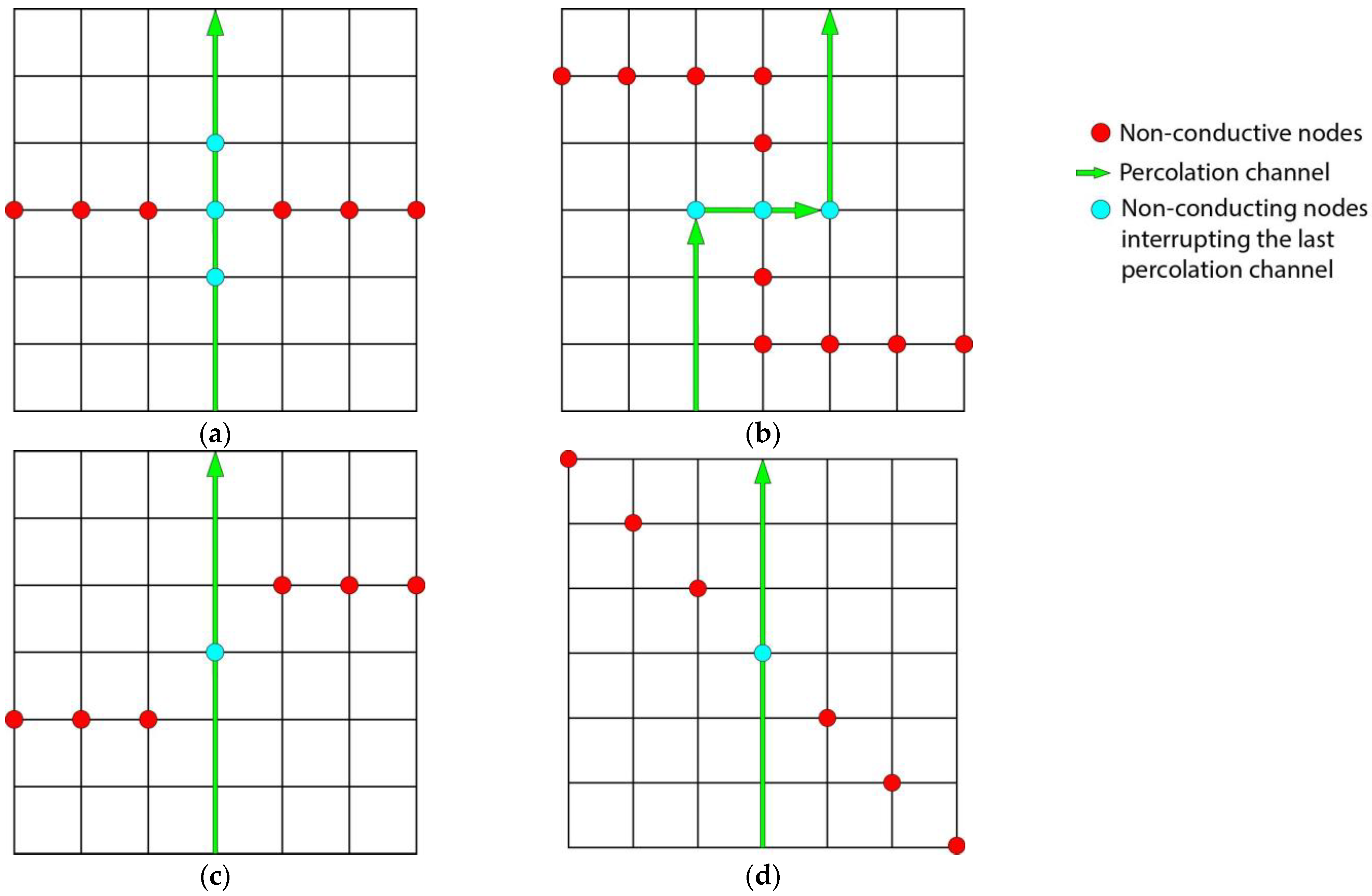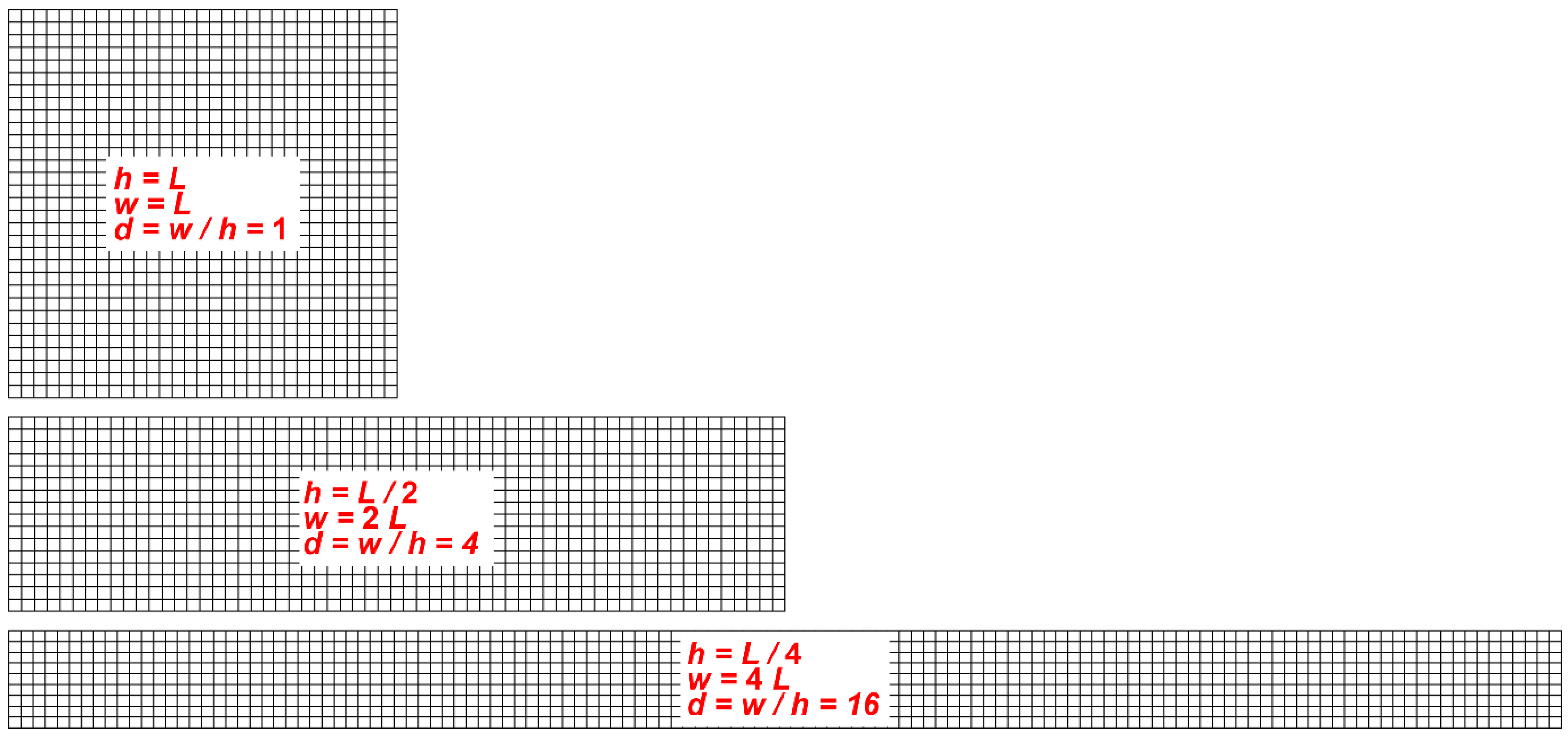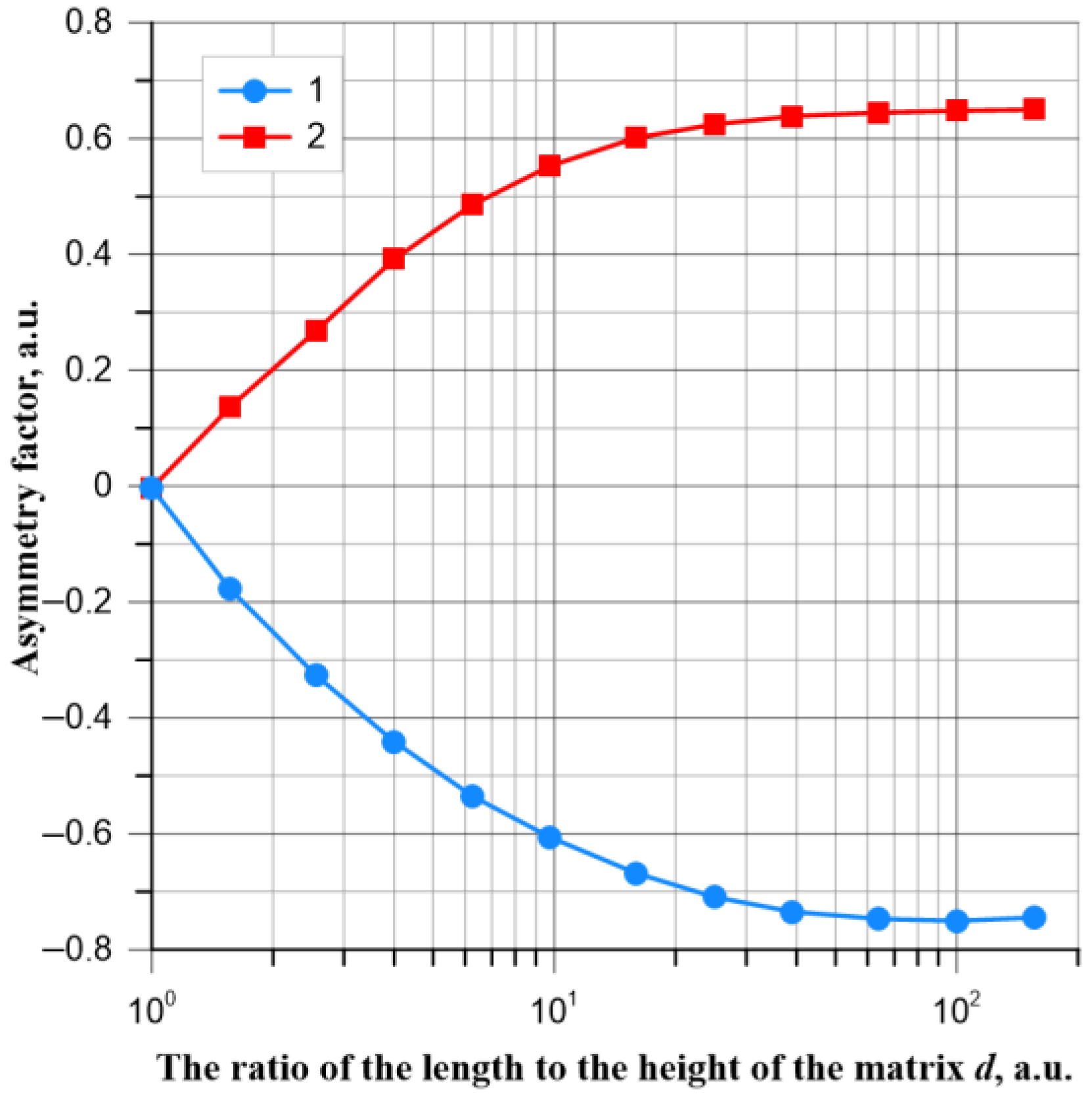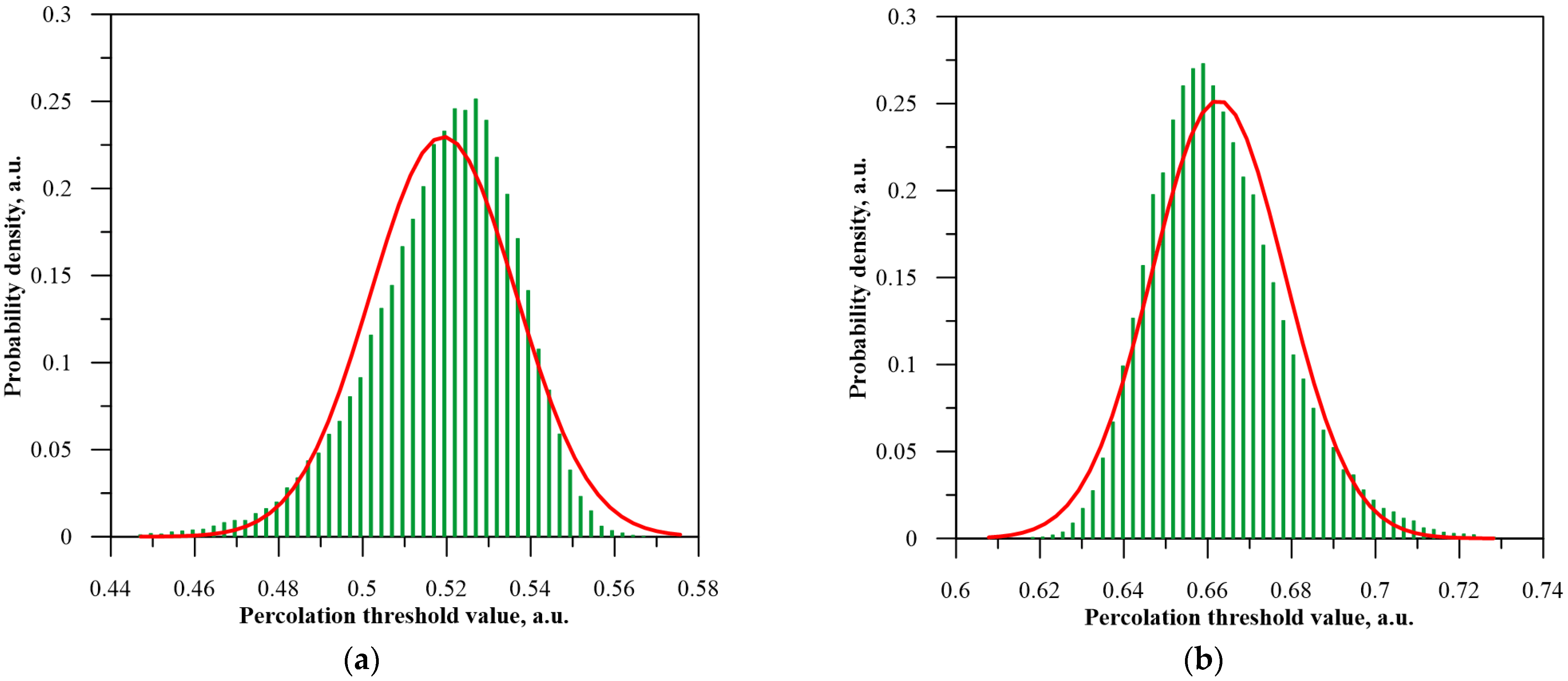Research on the Influence of Matrix Shape on Percolation Threshold Values for Current Flow Conducted Using the Monte Carlo Simulation Method
Abstract
1. Introduction
2. Materials and Methods
2.1. Test Method
2.2. Fundamentals of Statistical Analysis of Percolation Threshold Simulation Results
3. Research Results and Their Statistical Analysis
4. Conclusions
Author Contributions
Funding
Data Availability Statement
Conflicts of Interest
References
- Prat, M. Percolation Model of Drying under Isothermal Conditions in Porous Media. Int. J. Multiph. Flow 1993, 19, 691–704. [Google Scholar] [CrossRef]
- Rossen, W.R.; Gauglitz, P.A. Percolation Theory of Creation and Mobilization of Foams in Porous Media. AIChE J. 1990, 36, 1176–1188. [Google Scholar] [CrossRef]
- Stauffer, D.; Aharony, A. Introduction To Percolation Theory; Taylor & Francis: Abingdon, UK, 2018. [Google Scholar]
- Wilkinson, D.; Willemsen, J.F. Invasion Percolation: A New Form of Percolation Theory. J. Phys. A Math. Gen. 1983, 16, 3365–3376. [Google Scholar] [CrossRef]
- Kirkpatrick, S. Percolation and Conduction. Rev. Mod. Phys. 1973, 45, 574–588. [Google Scholar] [CrossRef]
- Hammersley, J.M.; Handscomb, D.C. Percolation Processes. In Monte Carlo Methods; Springer: Dordrecht, The Netherlands, 1964; pp. 134–141. [Google Scholar]
- Broadbent, S.R.; Hammersley, J.M. Percolation Processes. Math. Proc. Camb. Philos. Soc. 1957, 53, 629–641. [Google Scholar] [CrossRef]
- Sieradzki, K.; Corderman, R.R.; Shukla, K.; Newman, R.C. Computer Simulations of Corrosion: Selective Dissolution of Binary Alloys. Philos. Mag. A 1989, 59, 713–746. [Google Scholar] [CrossRef]
- Qiao, R.; Catherine Brinson, L. Simulation of Interphase Percolation and Gradients in Polymer Nanocomposites. Compos. Sci. Technol. 2009, 69, 491–499. [Google Scholar] [CrossRef]
- Benkstein, K.D.; Kopidakis, N.; van de Lagemaat, J.; Frank, A.J. Influence of the Percolation Network Geometry on Electron Transport in Dye-Sensitized Titanium Dioxide Solar Cells. J. Phys. Chem. B 2003, 107, 7759–7767. [Google Scholar] [CrossRef]
- Stanley, H.E.; Teixeira, J. Interpretation of the Unusual Behavior of H2O and D2O at Low Temperatures: Tests of a Percolation Model. J. Chem. Phys. 1980, 73, 3404–3422. [Google Scholar] [CrossRef]
- Newman, M.E.J.; Ziff, R.M. Efficient Monte Carlo Algorithm and High-Precision Results for Percolation. Phys. Rev. Lett. 2000, 85, 4104–4107. [Google Scholar] [CrossRef]
- Gawlinski, E.T.; Stanley, H.E. Continuum Percolation in Two Dimensions: Monte Carlo Tests of Scaling and Universality for Non-Interacting Discs. J. Phys. A Math. Gen. 1981, 14, L291–L299. [Google Scholar] [CrossRef]
- Sweeny, M. Monte Carlo Study of Weighted Percolation Clusters Relevant to the Potts Models. Phys. Rev. B 1983, 27, 4445–4455. [Google Scholar] [CrossRef]
- d’Iribarne, C.; Rasigni, G.; Rasigni, M. Determination of Site Percolation Transitions for 2D Mosaics by Means of the Minimal Spanning Tree Approach. Phys. Lett. A 1995, 209, 95–98. [Google Scholar] [CrossRef]
- Ziff, R.M.; Gu, H. Universal Condition for Critical Percolation Thresholds of Kagomé-like Lattices. Phys. Rev. E 2009, 79, 020102. [Google Scholar] [CrossRef]
- Suding, P.N.; Ziff, R.M. Site Percolation Thresholds for Archimedean Lattices. Phys. Rev. E 1999, 60, 275–283. [Google Scholar] [CrossRef] [PubMed]
- Sykes, M.F.; Essam, J.W. Exact Critical Percolation Probabilities for Site and Bond Problems in Two Dimensions. J. Math. Phys. 1964, 5, 1117–1127. [Google Scholar] [CrossRef]
- Lee, M.J. Complementary Algorithms for Graphs and Percolation. Phys. Rev. E 2007, 76, 027702. [Google Scholar] [CrossRef]
- Feng, X.; Deng, Y.; Blöte, H.W.J. Percolation Transitions in Two Dimensions. Phys. Rev. E 2008, 78, 031136. [Google Scholar] [CrossRef]
- Dean, P.; Bird, N.F. Monte Carlo Estimates of Critical Percolation Probabilities. Math. Proc. Camb. Philos. Soc. 1967, 63, 477–479. [Google Scholar] [CrossRef]
- Dean, P. A New Monte Carlo Method for Percolation Problems on a Lattice. Math. Proc. Camb. Philos. Soc. 1963, 59, 397–410. [Google Scholar] [CrossRef]
- Tencer, J.; Forsberg, K.M. Postprocessing Techniques for Gradient Percolation Predictions on the Square Lattice. Phys. Rev. E 2021, 103, 012115. [Google Scholar] [CrossRef]
- Wang, J.; Kazemi, Y.; Wang, S.; Hamidinejad, M.; Mahmud, M.B.; Pötschke, P.; Park, C.B. Enhancing the Electrical Conductivity of PP/CNT Nanocomposites through Crystal-Induced Volume Exclusion Effect with a Slow Cooling Rate. Compos. B Eng. 2020, 183, 107663. [Google Scholar] [CrossRef]
- Haghgoo, M.; Ansari, R.; Hassanzadeh-Aghdam, M.K.; Nankali, M. Analytical Formulation for Electrical Conductivity and Percolation Threshold of Epoxy Multiscale Nanocomposites Reinforced with Chopped Carbon Fibers and Wavy Carbon Nanotubes Considering Tunneling Resistivity. Compos. Part. A Appl. Sci. Manuf. 2019, 126, 105616. [Google Scholar] [CrossRef]
- Abdelrazek, E.M.; Abdelghany, A.M.; Tarabiah, A.E.; Zidan, H.M. AC Conductivity and Dielectric Characteristics of PVA/PVP Nanocomposite Filled with MWCNTs. J. Mater. Sci. Mater. Electron. 2019, 30, 15521–15533. [Google Scholar] [CrossRef]
- Qi, F.; Chen, N.; Wang, Q. Dielectric and Piezoelectric Properties in Selective Laser Sintered Polyamide11/BaTiO3/CNT Ternary Nanocomposites. Mater. Des. 2018, 143, 72–80. [Google Scholar] [CrossRef]
- Wang, Y.; Weng, G.J. Electrical Conductivity of Carbon Nanotube- and Graphene-Based Nanocomposites. In Micromechanics and Nanomechanics of Composite Solids; Springer International Publishing: Cham, Switzerland, 2018; pp. 123–156. [Google Scholar]
- Marsden, A.J.; Papageorgiou, D.G.; Vallés, C.; Liscio, A.; Palermo, V.; Bissett, M.A.; Young, R.J.; Kinloch, I.A. Electrical Percolation in Graphene-Polymer Composites. 2d Mater. 2018, 5, 032003. [Google Scholar] [CrossRef]
- Yu, Z.; Bai, Y.; Wang, J.H.; Li, Y. Effects of Functional Additives on Structure and Properties of Polycarbonate-Based Composites Filled with Hybrid Chopped Carbon Fiber/Graphene Nanoplatelet Fillers. ES Energy Environ. 2021, 12, 66–76. [Google Scholar] [CrossRef]
- Xie, P.; Liu, Y.; Feng, M.; Niu, M.; Liu, C.; Wu, N.; Sui, K.; Patil, R.R.; Pan, D.; Guo, Z.; et al. Hierarchically Porous Co/C Nanocomposites for Ultralight High-Performance Microwave Absorption. Adv. Compos. Hybrid. Mater. 2021, 4, 173–185. [Google Scholar] [CrossRef]
- Liu, H.-C.; Zeng, S.-M.; Li, R.; Jiang, Y.-P.; Liu, Q.-X.; Tang, X.-G. Multiferroic Properties and Resistive Switching Behaviors of Ni0.5Zn0.5FeO24 Thin Films. Adv. Compos. Hybrid. Mater. 2021, 4, 1–7. [Google Scholar] [CrossRef]
- Wang, X.; Shi, Z.; Chen, M.; Fan, R.; Yan, K.; Sun, K.; Pan, S.; Yu, M. Tunable Electromagnetic Properties in Co/Al2O3 Cermets Prepared by Wet Chemical Method. J. Am. Ceram. Soc. 2014, 97, 3223–3229. [Google Scholar] [CrossRef]
- Jiang, Y.; Xie, P.; Wang, Z.; Fan, G.; Qu, Y.; Sun, K.; Man, H.; Zhang, Z.; Liu, Y.; Fan, R. Iron Granular Percolative Composites toward Radio-Frequency Negative Permittivity. ECS J. Solid. State Sci. Technol. 2018, 7, N132–N136. [Google Scholar] [CrossRef]
- Ao, X.; Wang, X.; Tan, J.; Zhang, S.; Su, C.; Dong, L.; Tang, M.; Wang, Z.; Tian, B.; Wang, H. Nanocomposite with Fast Li+ Conducting Percolation Network: Solid Polymer Electrolyte with Li+ Non-Conducting Filler. Nano Energy 2021, 79, 105475. [Google Scholar] [CrossRef]
- Fang, C.; Zhang, J.; Chen, X.; Weng, G.J. Calculating the Electrical Conductivity of Graphene Nanoplatelet Polymer Composites by a Monte Carlo Method. Nanomaterials 2020, 10, 1129. [Google Scholar] [CrossRef] [PubMed]
- Khosla, A.; Shah, S.; Shiblee, M.N.I.; Mir, S.H.; Nagahara, L.A.; Thundat, T.; Shekar, P.K.; Kawakami, M.; Furukawa, H. Carbon Fiber Doped Thermosetting Elastomer for Flexible Sensors: Physical Properties and Microfabrication. Sci. Rep. 2018, 8, 12313. [Google Scholar] [CrossRef]
- Zukowski, P.; Koltunowicz, T.N.; Bondariev, V.; Fedotov, A.K.; Fedotova, J.A. Determining the Percolation Threshold for (FeCoZr)x(CaF2)(100−x) Nanocomposites Produced by Pure Argon Ion-Beam Sputtering. J. Alloys Compd. 2016, 683, 62–66. [Google Scholar] [CrossRef]
- Moya, J.S.; Lopez-Esteban, S.; Pecharromán, C. The Challenge of Ceramic/Metal Microcomposites and Nanocomposites. Prog. Mater. Sci. 2007, 52, 1017–1090. [Google Scholar] [CrossRef]
- Faupel, F.; Zaporojtchenko, V.; Strunskus, T.; Elbahri, M. Metal-Polymer Nanocomposites for Functional Applications. Adv. Eng. Mater. 2010, 12, 1177–1190. [Google Scholar] [CrossRef]
- Sarychev, A. Electromagnetic Field Fluctuations and Optical Nonlinearities in Metal-Dielectric Composites. Phys. Rep. 2000, 335, 275–371. [Google Scholar] [CrossRef]
- Singh, D.K.; Singh, S.; Singh, P. Nanomaterials; Singh, D.K., Singh, S., Singh, P., Eds.; Springer Nature: Singapore, 2023. [Google Scholar]
- Ramesh, K.T. Nanomaterials. In Nanomaterials; Springer: Boston, MA, USA, 2009; pp. 1–20. [Google Scholar]
- Mott, N.F.; Davis, E.A. Electronic Processes in Non-Crystalline Materials; Clarendon Press: Oxford, UK, 1979. [Google Scholar]
- Żukowski, P.; Kierczyński, K.; Koltunowicz, T.N.; Rogalski, P.; Subocz, J. Application of Elements of Quantum Mechanics in Analysing AC Conductivity and Determining the Dimensions of Water Nanodrops in the Composite of Cellulose and Mineral Oil. Cellulose 2019, 26, 2969–2985. [Google Scholar] [CrossRef]
- Svito, I.A.; Fedotov, A.K.; Saad, A.; Zukowski, P.; Koltunowicz, T.N. Influence of Oxide Matrix on Electron Transport in (FeCoZr)x(Al2O3)1-x Nanocomposite Films. J. Alloys Compd. 2017, 699, 818–823. [Google Scholar] [CrossRef]
- Pogrebnjak, A.; Ivashchenko, V.; Maksakova, O.; Buranich, V.; Konarski, P.; Bondariev, V.; Zukowski, P.; Skrynskyy, P.; Sinelnichenko, A.; Shelest, I.; et al. Comparative Measurements and Analysis of the Mechanical and Electrical Properties of Ti-Zr-C Nanocomposite: Role of Stoichiometry. Measurement 2021, 176, 109223. [Google Scholar] [CrossRef]
- Zukowski, P.; Galaszkiewicz, P.; Bondariev, V.; Okal, P.; Pogrebnjak, A.; Kupchishin, A.; Ruban, A.; Pogorielov, M.; Koltunowicz, T.N. Comparative Measurements and Analysis of the Electrical Properties of Nanocomposites TixZr1−xC+α-Cy (0.0 ≤ x ≤ 1.0). Materials 2022, 15, 7908. [Google Scholar] [CrossRef] [PubMed]
- Koltunovich, T.N.; Galashkevich, P.; Kierczynski, K.; Rogalski, P.; Okal, P.; Pogrebnjak, A.D.; Buranich, V.; Pogorielov, M.; Diedkova, K.; Zahorodna, V.; et al. Investigation of AC Electrical Properties of MXene-PCL Nanocomposites for Application in Small and Medium Power Generation. Energies 2021, 14, 7123. [Google Scholar] [CrossRef]
- Zukowski, P.; Okal, P.; Kierczynski, K.; Rogalski, P.; Bondariev, V. Analysis of Uneven Distribution of Nodes Creating a Percolation Channel in Matrices with Translational Symmetry for Direct Current. Energies 2023, 16, 7647. [Google Scholar] [CrossRef]
- Zukowski, P.; Okal, P.; Kierczynski, K.; Rogalski, P.; Borucki, S.; Kunicki, M.; Koltunowicz, T.N. Investigations into the Influence of Matrix Dimensions and Number of Iterations on the Percolation Phenomenon for Direct Current. Energies 2023, 16, 7128. [Google Scholar] [CrossRef]
- Gilli, M.; Maringer, D.; Schumann, E. Generating Random Numbers. In Numerical Methods and Optimization in Finance; Elsevier: Amsterdam, The Netherlands, 2019; pp. 103–132. [Google Scholar]
- Gentle, J.E. Computational Statistics. In International Encyclopedia of Education; Elsevier: Amsterdam, The Netherlands, 2010; pp. 93–97. [Google Scholar]
- Muralidhar, K. Monte Carlo Simulation. In Encyclopedia of Information Systems; Elsevier: Amsterdam, The Netherlands, 2003; pp. 193–201. [Google Scholar]
- Johansen, A.M. Monte Carlo Methods. In International Encyclopedia of Education; Elsevier: Amsterdam, The Netherlands, 2010; pp. 296–303. [Google Scholar]
- Matsumoto, M.; Nishimura, T. Mersenne Twister. ACM Trans. Model. Comput. Simul. 1998, 8, 3–30. [Google Scholar] [CrossRef]
- Noel, K. Analysis of Random Generators in Monte Carlo Simulation: The Mersenne Twister and Sobol. SSRN Electron. J. 2016. [Google Scholar] [CrossRef]
- Nowak, R. Statistics For Physicists; Wydawnicto Naukowe Pwn: Warszawa, Poland, 2002. [Google Scholar]
- Wasselynck, G.; Trichet, D.; Fouladgar, J. Determination of the Electrical Conductivity Tensor of a CFRP Composite Using a 3-D Percolation Model. IEEE Trans. Magn. 2013, 49, 1825–1828. [Google Scholar] [CrossRef]
- Aryanfar, A.; Medlej, S.; Tarhini, A.; Damadi, S.R.; Tehrani, B.A.R.; Goddard B., W.A., III. 3D Percolation Modeling for Predicting the Thermal Conductivity of Graphene-Polymer Composites. Comput. Mater. Sci. 2021, 197, 110650. [Google Scholar] [CrossRef]
- Rímská, Z.; Křuesalek, V.; Spacek, J. AC Conductivity of Carbon Fiber-Polymer Matrix Composites at the Percolation Threshold. Polym. Compos. 2002, 23, 95–103. [Google Scholar] [CrossRef]
- Wang, M.; Gurunathan, R.; Imasato, K.; Geisendorfer, N.R.; Jakus, A.E.; Peng, J.; Shah, R.N.; Grayson, M.; Snyder, G.J. A Percolation Model for Piezoresistivity in Conductor-Polymer Composites. Adv. Theory Simul. 2019, 2, 1800125. [Google Scholar] [CrossRef]
- Rahaman, M.; Aldalbahi, A.; Govindasami, P.; Khanam, N.; Bhandari, S.; Feng, P.; Altalhi, T. A New Insight in Determining the Percolation Threshold of Electrical Conductivity for Extrinsically Conducting Polymer Composites through Different Sigmoidal Models. Polymers 2017, 9, 527. [Google Scholar] [CrossRef] [PubMed]
- Zare, Y.; Rhee, K.Y. A Simple Methodology to Predict the Tunneling Conductivity of Polymer/CNT Nanocomposites by the Roles of Tunneling Distance, Interphase and CNT Waviness. RSC Adv. 2017, 7, 34912–34921. [Google Scholar] [CrossRef]
- Tomes, O.; Soul, A.; Zhang, H.; Bilotti, E.; Papageorgiou, D.G. A Novel Electrical Depercolation Model for Stretchable Nanocomposite Strain Sensors. Nanoscale 2024, 16, 6163–6175. [Google Scholar] [CrossRef]
- Zare, Y.; Rhee, K.-Y.; Park, S.-J. A Developed Equation for Electrical Conductivity of Polymer Carbon Nanotubes (CNT) Nanocomposites Based on Halpin-Tsai Model. Results Phys. 2019, 14, 102406. [Google Scholar] [CrossRef]
- Wang, L.; Song, P.; Lin, C.-T.; Kong, J.; Gu, J. 3D Shapeable, Superior Electrically Conductive Cellulose Nanofibers/Ti3C2Tx MXene Aerogels/Epoxy Nanocomposites for Promising EMI Shielding. Research 2020, 2020, 4093732. [Google Scholar] [CrossRef]
- Hicks, J.; Behnam, A.; Ural, A. A Computational Study of Tunneling-Percolation Electrical Transport in Graphene-Based Nanocomposites. Appl. Phys. Lett. 2009, 95, 213103. [Google Scholar] [CrossRef]








| No. | Width w, a.u. | Height h, a.u. | d = w/h, a.u. |
|---|---|---|---|
| 1 | 200 | 200 | 1.0 |
| 2 | 250 | 160 | 1.5625 |
| 3 | 320 | 125 | 2.56 |
| 4 | 400 | 100 | 4 |
| 5 | 500 | 80 | 6.25 |
| 6 | 625 | 64 | 9.765625 |
| 7 | 800 | 50 | 16 |
| 8 | 1000 | 40 | 25 |
| 9 | 1250 | 32 | 39.0625 |
| 10 | 1600 | 25 | 64 |
| 11 | 2000 | 20 | 100 |
| 12 | 2500 | 16 | 156.25 |
| No. | d = w/h, a.u. | Xc(h) | Xc(w) | σ(h) | σ(w) |
|---|---|---|---|---|---|
| 1 | 1 | 0.592740 | 0.592665 | 0.009733 | 0.009732 |
| 2 | 1.563 | 0.586701 | 0.598780 | 0.009957 | 0.009762 |
| 3 | 2.56 | 0.579393 | 0.605901 | 0.010430 | 0.010249 |
| 4 | 4 | 0.571695 | 0.613361 | 0.011219 | 0.010920 |
| 5 | 6.25 | 0.562493 | 0.622363 | 0.012317 | 0.011890 |
| 6 | 9.766 | 0.551302 | 0.632831 | 0.013600 | 0.012914 |
| 7 | 16 | 0.536080 | 0.647067 | 0.015315 | 0.014391 |
| 8 | 25 | 0.519199 | 0.662514 | 0.017365 | 0.015844 |
| 9 | 39.063 | 0.498584 | 0.681040 | 0.019546 | 0.017558 |
| 10 | 64 | 0.470639 | 0.705252 | 0.022172 | 0.019174 |
| 11 | 100 | 0.439963 | 0.730792 | 0.024886 | 0.020645 |
| 12 | 156.25 | 0.403614 | 0.759847 | 0.027463 | 0.021989 |
Disclaimer/Publisher’s Note: The statements, opinions and data contained in all publications are solely those of the individual author(s) and contributor(s) and not of MDPI and/or the editor(s). MDPI and/or the editor(s) disclaim responsibility for any injury to people or property resulting from any ideas, methods, instructions or products referred to in the content. |
© 2024 by the authors. Licensee MDPI, Basel, Switzerland. This article is an open access article distributed under the terms and conditions of the Creative Commons Attribution (CC BY) license (https://creativecommons.org/licenses/by/4.0/).
Share and Cite
Bondariev, V.; Okal, P.; Rogalski, P.; Pogrebnjak, A.; Zukowski, P. Research on the Influence of Matrix Shape on Percolation Threshold Values for Current Flow Conducted Using the Monte Carlo Simulation Method. Energies 2024, 17, 4777. https://doi.org/10.3390/en17194777
Bondariev V, Okal P, Rogalski P, Pogrebnjak A, Zukowski P. Research on the Influence of Matrix Shape on Percolation Threshold Values for Current Flow Conducted Using the Monte Carlo Simulation Method. Energies. 2024; 17(19):4777. https://doi.org/10.3390/en17194777
Chicago/Turabian StyleBondariev, Vitalii, Pawel Okal, Przemyslaw Rogalski, Alexander Pogrebnjak, and Pawel Zukowski. 2024. "Research on the Influence of Matrix Shape on Percolation Threshold Values for Current Flow Conducted Using the Monte Carlo Simulation Method" Energies 17, no. 19: 4777. https://doi.org/10.3390/en17194777
APA StyleBondariev, V., Okal, P., Rogalski, P., Pogrebnjak, A., & Zukowski, P. (2024). Research on the Influence of Matrix Shape on Percolation Threshold Values for Current Flow Conducted Using the Monte Carlo Simulation Method. Energies, 17(19), 4777. https://doi.org/10.3390/en17194777







